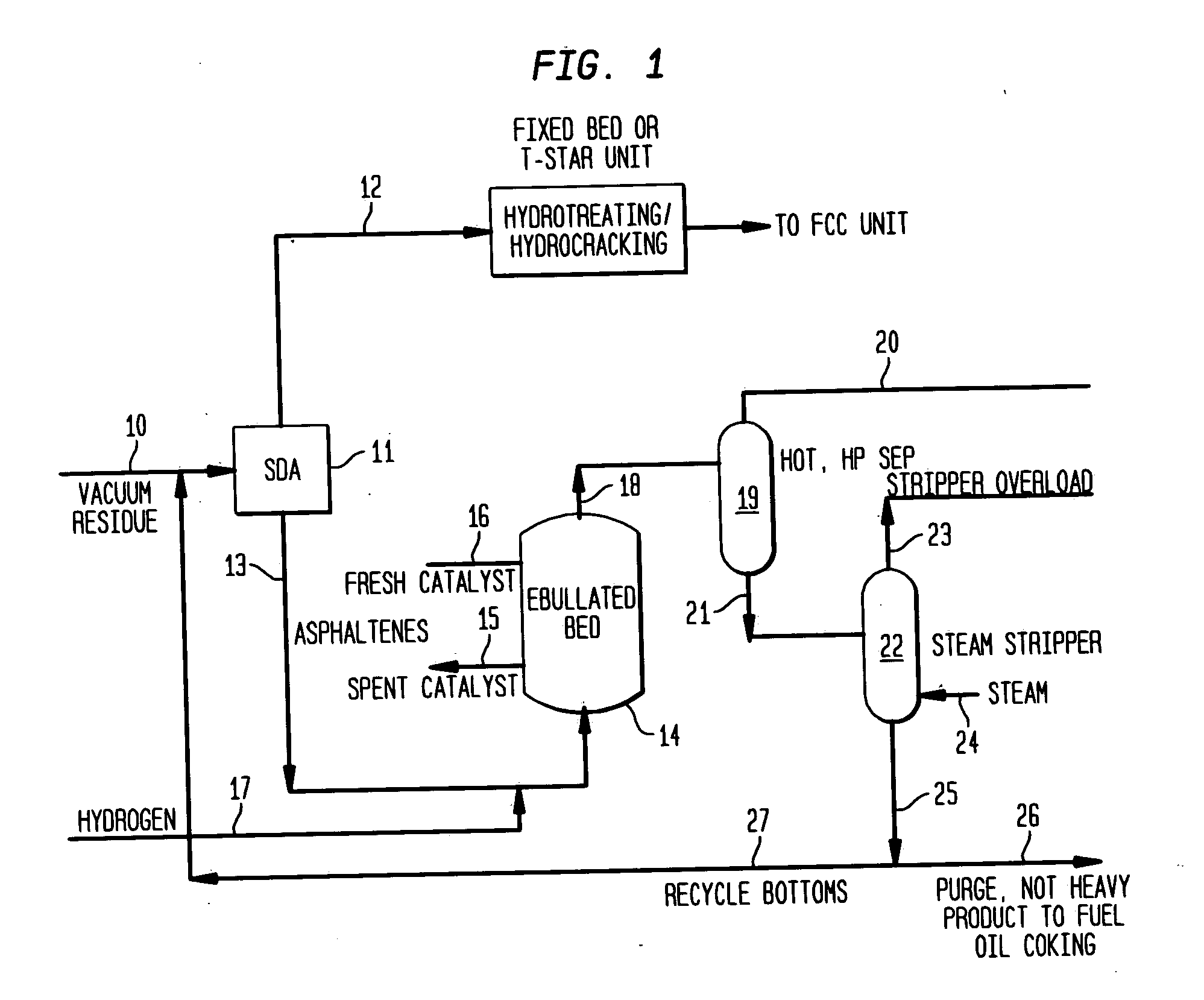Integrated SDA and ebullated-bed process
a technology of ebullated bed and integrated sda, which is applied in the field of integrated sda and ebullated bed process, can solve the problems of increasing the increasing the processing cost of the overall plant, and increasing the amount of impurities in the crude petroleum. , to achieve the effect of minimizing the chance of asphaltene precipitation and subsequent fouling, wide pore catalyst, and maximum efficiency
- Summary
- Abstract
- Description
- Claims
- Application Information
AI Technical Summary
Benefits of technology
Problems solved by technology
Method used
Image
Examples
example 1
[0075] Further understanding of the present invention is illustrated in the following example as described below. A vacuum residue feedstock derived from a Western Canadian heavy crude is processed in order to produce distillate material and a heavy fuel oil. Because of the heavy nature (high CCR and metals) of this crude, an ebullated-bed reactor is utilized.
[0076] This example will illustrate and compare conventional processing and processing incorporating this invention. The Western Canadian vacuum residue has the following inspections (Table 4) and yields / qualities when processed in a C5 solvent utilizing SDA unit.
TABLE 3VacuumResidueAsphaltenesC5 DAOW %10042.157.9Gravity,3.0−5.79.3°APIResidue9410090Content(975° F.),Wt. %Nitrogen,0.620.850.42Wt. %Sulfur, wt. %5.537.364.2CCR, W %244010Nickel,11523030wppmVanadium,27055070WppmC71740Less thaninsolubles,50 wppmW %
In a pre-invention processing configuration, all of the vacuum residue is sent to an ebullated-bed reactor system and ...
example 2
An atmospheric residue feedstock derived from a heavy crude is distilled into a vacuum gas oil (14 w %) and a vacuum residue (86 w %).
[0080] The vacuum residue has the following inspections and yields / qualities when processed in a SDA unit using a C4 solvent.
VacuumPureC4 DAO + vacuumResidueC4 DAOgasoilAsphaltenesW %10053—47W % to the8645.659.640.4atmosphericresidueResidue9490.068.8100content(975° F.+),w %Specific1.060.98800.981.114GravitySulfur, wt %5.74.03.66.3Nitrogen,6800300024009950wt %CCR, wt %256.4545Nickel,1101510215wppmVanadium,2702215495wppmC71531insolubles,w %
In the present invention the asphaltenes are sent to an ebullated-bed reactor system while the C4 DAO is mixed with the vacuum gas oil to be processed in a fixed bed mild hydrocracking unit.
The ebullated-bed reactor used is composed of two reactors using NiMo catalyst. The operating conditions are the following:
[0081] total pressure: 2900 psi (20 MPa)
[0082] LHSV=0.3 hr−1
[0083] H2 to hydrocarbon ratio=4,000 s...
PUM
 Login to View More
Login to View More Abstract
Description
Claims
Application Information
 Login to View More
Login to View More - R&D
- Intellectual Property
- Life Sciences
- Materials
- Tech Scout
- Unparalleled Data Quality
- Higher Quality Content
- 60% Fewer Hallucinations
Browse by: Latest US Patents, China's latest patents, Technical Efficacy Thesaurus, Application Domain, Technology Topic, Popular Technical Reports.
© 2025 PatSnap. All rights reserved.Legal|Privacy policy|Modern Slavery Act Transparency Statement|Sitemap|About US| Contact US: help@patsnap.com


